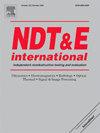Single transmission phase- and frequency-modulated coded excitation for enhanced inspection of thick complex industrial components using a scalable, flexible, lead-free, ultrasonic array
IF 4.5
2区 材料科学
Q1 MATERIALS SCIENCE, CHARACTERIZATION & TESTING
引用次数: 0
Abstract
To address the growing challenge of applying ultrasonic non-destructive evaluation to complex industrial components, flexible ultrasonic arrays have emerged as a conformable solution to inspect such geometries, thereby removing the need for custom-designed wedges to conform to surfaces. Flexible lead-based arrays have been used in prior research. They offer high piezoelectric coefficient, however, they pose human health and environmental risks, and fail to comply with global initiatives including the Restriction of Hazardous Substances (RoHS) regulation enacted by the European Union. Although numerous studies on the piezoelectric properties of lead-free materials have been conducted, the uptake of technology and implementation in practice has been slow. In this work, a scalable, RoHS-compliant, flexible ultrasonic array was employed to improve operability in thick convex and concave components. However, the lead-free array exhibits lower piezoelectric coefficient compared to its lead-based counterparts, resulting in reduced signal quality. To tackle this shortcoming, single transmission phase-modulated Barker and frequency-modulated chirp excitation schemes, in conjunction with pulse compression, were employed to improve the signal quality. Subsequently, their impact was studied in terms of imaging quality, through Full Matrix Capture (FMC) acquisition methodology and Total Focusing Method (TFM) imaging, and Signal-to-Noise Ratio (SNR) measurements. A novel SNR method was presented. Existing SNR approaches evaluate image quality by calculating it within a designated area surrounding the target, where the noise level is quantified as the root mean square of the image noise, omitting any indication of the target. In addition to the noise level, artifacts from matched filters and sidelobes require quantitative evaluation. The new SNR technique was proposed to automate the selection of regions when characterising the SNR. The SNR was calculated across regions of varying size, with the region size where the SNR values converged being selected. This technique was utilised in a comparative analysis including a single-cycle pulse excitation, modulated Barker and chirp excitation schemes with equivalent energy levels in simulation and experimentally. The simulated and experimental results showed good agreement, with some discrepancies attributed to imperfections in the experimental conditions. SNR improvement exceeding 2.6 dB was observed experimentally, with the coded excitation techniques showing higher SNR and better image quality without sacrificing acquisition speed. Moreover, sidelobe artifacts were evident in all TFM images, while the coded excitation images further exhibited matched filter processing artifacts. The flexibility of the array was assessed in the subsequent two experiments to determine its effectiveness in improving operability in complex-geometry samples. The convex and concave samples pre-aligned the array to promote a converging and diverging ultrasonic beam, respectively. In all cases, the array demonstrated excellent conformity with the components, and the coded excitation schemes consistently achieved better imaging quality relative to the pulse excitation case.
单传输相位和频率调制编码激励增强检查厚复杂的工业部件使用可扩展的,灵活的,无铅的,超声波阵列
为了解决将超声波无损检测应用于复杂工业部件这一日益严峻的挑战,柔性超声波阵列已经成为检测此类几何形状的一种合适的解决方案,从而消除了定制设计楔形板以符合表面的需求。柔性铅基阵列已在先前的研究中使用。然而,它们具有高压电系数,对人类健康和环境构成风险,并且不符合包括欧盟颁布的有害物质限制(RoHS)法规在内的全球倡议。虽然对无铅材料的压电性能进行了大量的研究,但技术的吸收和实践的实施一直很缓慢。在这项工作中,采用可扩展,符合rohs标准的柔性超声阵列来提高厚凸和凹组件的可操作性。然而,与含铅阵列相比,无铅阵列的压电系数较低,导致信号质量下降。为了解决这一缺点,采用单传输调相巴克和调频啁啾激励方案,结合脉冲压缩,以提高信号质量。随后,通过全矩阵捕获(FMC)采集方法和全聚焦法(TFM)成像以及信噪比(SNR)测量,研究了它们对成像质量的影响。提出了一种新的信噪比方法。现有的信噪比方法通过在目标周围的指定区域内计算信噪比来评估图像质量,其中噪声电平被量化为图像噪声的均方根,忽略了目标的任何指示。除了噪声水平外,匹配滤波器和副瓣产生的伪影也需要定量评估。提出了一种新的信噪比技术,用于在表征信噪比时自动选择区域。在不同大小的区域中计算信噪比,选择信噪比值收敛的区域大小。该技术在模拟和实验中用于比较分析,包括单周期脉冲激励,具有等效能级的调制巴克和啁啾激励方案。模拟结果与实验结果吻合较好,但由于实验条件的不完善,存在一些差异。实验结果表明,编码激励技术在不牺牲采集速度的情况下,具有更高的信噪比和更好的图像质量。此外,所有TFM图像都存在明显的副瓣伪影,编码后的激励图像进一步呈现出匹配的滤波处理伪影。在随后的两个实验中评估了该阵列的灵活性,以确定其在复杂几何样品中提高可操作性的有效性。凸面和凹面样品分别对阵列进行预对准,以促进超声光束的会聚和发散。在所有情况下,阵列与组件表现出良好的一致性,编码激励方案相对于脉冲激励方案始终获得更好的成像质量。
本文章由计算机程序翻译,如有差异,请以英文原文为准。
求助全文
约1分钟内获得全文
求助全文
来源期刊

Ndt & E International
工程技术-材料科学:表征与测试
CiteScore
7.20
自引率
9.50%
发文量
121
审稿时长
55 days
期刊介绍:
NDT&E international publishes peer-reviewed results of original research and development in all categories of the fields of nondestructive testing and evaluation including ultrasonics, electromagnetics, radiography, optical and thermal methods. In addition to traditional NDE topics, the emerging technology area of inspection of civil structures and materials is also emphasized. The journal publishes original papers on research and development of new inspection techniques and methods, as well as on novel and innovative applications of established methods. Papers on NDE sensors and their applications both for inspection and process control, as well as papers describing novel NDE systems for structural health monitoring and their performance in industrial settings are also considered. Other regular features include international news, new equipment and a calendar of forthcoming worldwide meetings. This journal is listed in Current Contents.
 求助内容:
求助内容: 应助结果提醒方式:
应助结果提醒方式:


